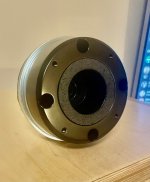https://www.purplewave.com/auction/..._Equipment-Concrete_Equip._or_Acces.-MissouriThat downspout looks interesting. I'll have to look up the dimensions. Unfortunately my phone focused on the fence not the horn but I walk by this several times/week and wonder about its potential. Intriguing at least by sheer size.
Is it necessary to cross the last 2-3 octave in another horn?
I saw this point of view from lenardaudio, suggested to use 2 separate horn for HF part.
One cover ~1k - 7kHz. And the rest of the part use compression tweeters.
A while ago I also saw juanitox says the B&C DCM414 compression midrange is more attractive to him because he/she didn't think
the same horn can load the HF part well.
The summation of DCX464 compression coaxial attract me but not sure how important the horn loading is at the last octaves.
Can anyone share their experience with compression tweeters?
It seems nowadays there's not much choice. B&C, Faitalpro, Ciare, Beyma have the more affordable products.
I saw this point of view from lenardaudio, suggested to use 2 separate horn for HF part.
One cover ~1k - 7kHz. And the rest of the part use compression tweeters.
A while ago I also saw juanitox says the B&C DCM414 compression midrange is more attractive to him because he/she didn't think
the same horn can load the HF part well.
The summation of DCX464 compression coaxial attract me but not sure how important the horn loading is at the last octaves.
Can anyone share their experience with compression tweeters?
It seems nowadays there's not much choice. B&C, Faitalpro, Ciare, Beyma have the more affordable products.
sorry but don't bother with that I'm a moth in a sweater 😉because he/she
the only time i have tried to do that was with a 50CmJ ABO Horn and a 18 sounds NSD3N and even with the right correction the last octave was not there like it should sound .
This won't work, due to the oval 'throat' transition and the semi-parabolic profile > acts like a reflector:How about this horn? Anyone want to try it? (Actually, it is a downspout from Trex, a manufacturer of composite decking) 😉
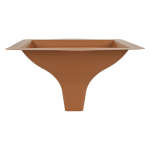
This could work - possibly surprisingly well, if you smooth out the 'steps' at the 'throat' and mouth edges.
Parallel walls are undesirable, but the disadvantages will be partly compensated by the throat transition.
The throat is actually huge > 5.5" diameter, suitable for a full-range cone driver.
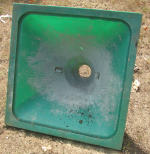
Last edited:
I think WAF has to come into play here. I get away with larger horns as long as they are pretty.
I’ve tried a couple in a 3-way, but couldn’t integrate them well. Even with dsp and delays. I found the “oneness” of sound in the two-way well worth the trade-off.Can anyone share their experience with compression tweeters?
It seems nowadays there's not much choice. B&C, Faitalpro, Ciare, Beyma have the more affordable products.
This could work - possibly surprisingly well, if you smooth out the 'steps' at the 'throat' and mouth edges.
Parallel walls are undesirable, but the disadvantages will be partly compensated by the throat transition.
The throat is actually huge > 5.5" diameter, suitable for a full-range cone driver.
View attachment 1182548
One could use such a concrete chute funnel as a mold. you can stretch fabric (fiberglass, fleece, spandex, etc.) including a round over at the mouth, which you could then spray with an (epoxy) hardener/raisin.
I would build up the horn walls with a mixture of sawdust/woodputty between the layers of fabric for extra damping, similar to the Community glassfiber horns.
Then CNC and/or print a throat adapter and your gigantic horn is ready. The rounded corners in the funnel make for a smoother response, especially when a similar roundover is added to the mouth.
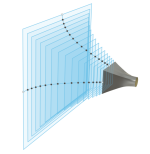
I think WAF has to come into play here. I get away with larger horns as long as they are pretty.
There's no substitute for cubic inches 😉
But you could build a 50l/92dB or 100l/95dB elegant slim column that plays almost full range (from about 30 Hz) with wide dispersion and sufficient output capacity for a large house party.
Yes, that additional mid driver is a potential cause of headaches, with the possible exception of a 2-way (from about 150 Hz) + bass section, like this:I’ve tried a couple in a 3-way, but couldn’t integrate them well. Even with dsp and delays. I found the “oneness” of sound in the two-way well worth the trade-off.
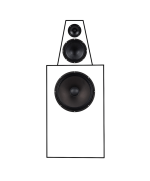
3 drivers + 3 crossover components > obviously not something for the 'flat everything community' 😉
Ah someone else who appreciates these exellent sounding speakers.And a high quality midwoofer > check Mms/BL and Flux Density. No need for shorting rings etc.
View attachment 1179088
Not many people even in the pa business have heard these.
The whole Studio line was exellent.
We where almost a fan club of Fane in the mid to late eighties.
I owned the 15B, 8m, 5m, ST5022.
My friend had the 15L, 10M and HT405.
My brother build some impessive PAs with exclusively Fane Chassis.
I still got the ST5022 Tweeters that I will hold on to. Best bullet tweeter I have heard to date.
Greets Klaus
Finally get DCX464 in hand...it's really big and heavy.
Anyone tried to use 1.4" throat compression driver on 1.5" horn?
Are the horn parts from JBL for 1.5"? Why don't they mention about the mounting distance and throat size......
Seems that XT1464/PR614/HF950 are still the more affordable choice.
Now I'm not sure to go for 90 degree coverage or 60 degree for home use.
I saw the D2 measurement at audioheritage. Is TD-2001/TD-4001 still perform better compare to D2 driver?
Distortion data measured by @DualTriode is also quite good shown prerviously in the thread
Anyone tried to use 1.4" throat compression driver on 1.5" horn?
Are the horn parts from JBL for 1.5"? Why don't they mention about the mounting distance and throat size......
Seems that XT1464/PR614/HF950 are still the more affordable choice.
Now I'm not sure to go for 90 degree coverage or 60 degree for home use.
I saw the D2 measurement at audioheritage. Is TD-2001/TD-4001 still perform better compare to D2 driver?
Distortion data measured by @DualTriode is also quite good shown prerviously in the thread
Probably not, because it may cause diffraction problems. You may try and let us know! 👍Anyone tried to use 1.4" throat compression driver on 1.5" horn?
I guess it's ND850 not N850? N850 weights 6kg...whoagreat , also received my RCF 850N 2inch , i 'm waiting for a LMH 50cm tratrix horn to use them and see if they can really go as low as 500hz 😉
How much does thae horn cost?
There don't seem to be any adapters that go from 1.4" to 1.5" maybe you can DIY something. (It would be very thin, which could prove an almost insurmountable challenge to get right.) I expect that diffraction at the resulting step would be an issue if you just bolt it directly on.
There's a product from 18sound convert 1.5" to 1.4" ......why don't they have a reverse one 😢
Pretty strange since other adaptor from them is to convert from small exit to large exit...
I guess I'd better avoid looking for 1.5" horn for my use case.
Pretty strange since other adaptor from them is to convert from small exit to large exit...
I guess I'd better avoid looking for 1.5" horn for my use case.
i don't see why you can't use it on both way ?There's a product from 18sound convert 1.5" to 1.4" ......why don't they have a reverse one 😢
One way has been to use non-hardening modeling clay and fill in the horn's throat entrance. Using a straight-edge rule, move around the throat entrance, then work the clay into a smooth transition from the entrance (1.5") to the attached 1.4" compression driver exit, as far into the horn as you wish. Voila! A custom transition. The advantage is that this doesn't necessarily increase the entrance length to the horn, which has a definite deleterious effect on high frequency polar coverage.Anyone tried to use 1.4" throat compression driver on 1.5" horn?
This technique was recommended by a well-known acoustic horn engineer.
Chris
Last edited:
It seems to me the seal/gasket would be a problem on the adaptor/horn side. I think compression driver have the foam to have good seal with the horn if the adaptor use reversely the horn won't have good seal with the adaptor right?i don't see why you can't use it on both way ?
Or it's actually not a problem?
- Home
- Loudspeakers
- Multi-Way
- Best Compression Drivers today 2022?
